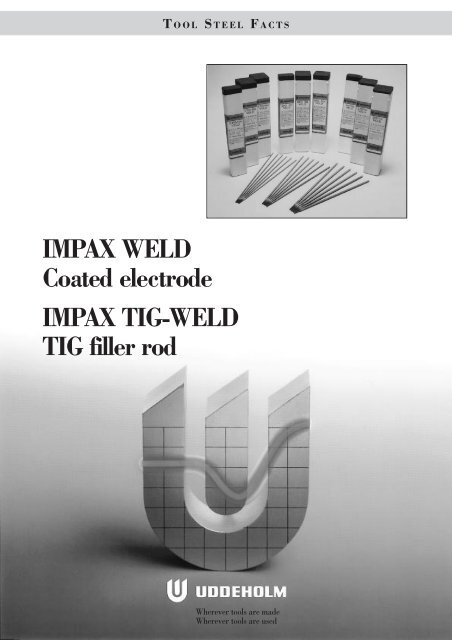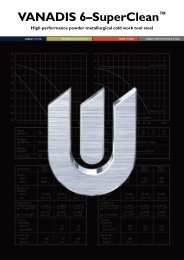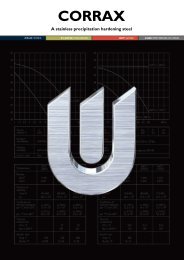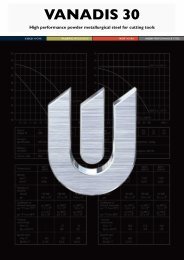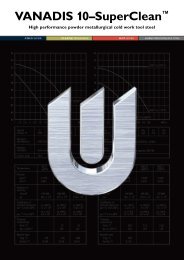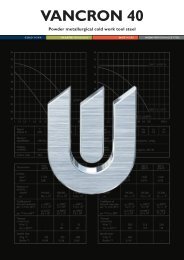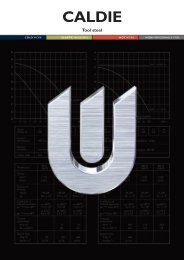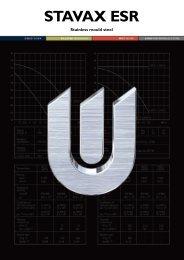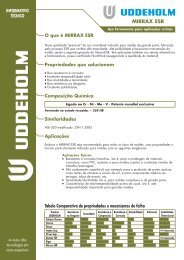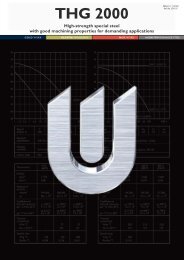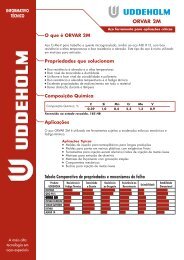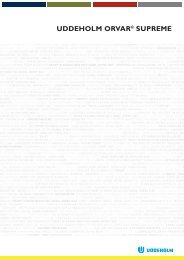IMPAX WELD Coated electrode IMPAX TIG-WELD TIG ... - Uddeholm
IMPAX WELD Coated electrode IMPAX TIG-WELD TIG ... - Uddeholm
IMPAX WELD Coated electrode IMPAX TIG-WELD TIG ... - Uddeholm
Create successful ePaper yourself
Turn your PDF publications into a flip-book with our unique Google optimized e-Paper software.
T OOL STEEL FACTS<br />
<strong>IMPAX</strong> <strong>WELD</strong><br />
<strong>Coated</strong> <strong>electrode</strong><br />
<strong>IMPAX</strong> <strong>TIG</strong>-<strong>WELD</strong><br />
<strong>TIG</strong> filler rod<br />
Wherever tools are made<br />
Wherever tools are used
<strong>IMPAX</strong> <strong>WELD</strong>/<br />
<strong>TIG</strong>-<strong>WELD</strong><br />
Welding of<br />
mould steel<br />
<strong>IMPAX</strong> <strong>WELD</strong> is a basic coated <strong>electrode</strong> and<br />
<strong>IMPAX</strong> <strong>TIG</strong>-<strong>WELD</strong> is a <strong>TIG</strong> filler rod special composed<br />
as to be compatible with the <strong>Uddeholm</strong><br />
mould steel <strong>IMPAX</strong> SUPREME.<br />
<strong>IMPAX</strong> <strong>WELD</strong> and <strong>IMPAX</strong> <strong>TIG</strong>-<strong>WELD</strong> give a weld<br />
metal almost identical in composition to <strong>IMPAX</strong><br />
SUPREME.<br />
Hardness after welding approx. 330 HB gives a<br />
weld metal well matched to the base mould steel,<br />
with good polishability and suitable for photoetching.<br />
<strong>IMPAX</strong> <strong>WELD</strong><br />
Weld current: DC positive pole.<br />
Diameter Length Current Volt<br />
mm mm A approx.<br />
2.5 350 90–110 23<br />
3.25 350 120–150 24<br />
4.0 350 170–200 26<br />
Redrying temperature 350°C (660°F), 2 hours.<br />
Welding of<br />
<strong>IMPAX</strong> SUPREME<br />
INTRODUCTION<br />
Good results when welding tool steel can be<br />
achieved if proper precautions are taken during<br />
welding (elevated working temperature, joint<br />
preparation, choice of consumables and welding<br />
procedure).<br />
Welding method <strong>TIG</strong> MMA<br />
Filler metal<br />
<strong>IMPAX</strong><br />
<strong>TIG</strong>-<strong>WELD</strong> <strong>IMPAX</strong> <strong>WELD</strong><br />
Hardness<br />
after welding 300–330 HB 300–330 HB<br />
CLEANING OF TOOL<br />
Clean the tool carefully with degreasing agent or<br />
by grinding before welding. The surfaces in the vicinity<br />
of the intended repairs/adjustment should<br />
be cleaned to base metal prior to doing anything.<br />
Make sure that cavity surfaces are well protected<br />
during welding, especially if these are polished.<br />
<strong>IMPAX</strong> <strong>TIG</strong>-<strong>WELD</strong><br />
Diameter, mm<br />
Length, mm<br />
1.0 1000<br />
1.6 1000<br />
Storage of <strong>electrode</strong>s<br />
Always keep the <strong>electrode</strong>s in a thermostaticallycontrolled<br />
drying cabinet 50–150°C (120–300°F),<br />
once the pack has been opened. The <strong>electrode</strong>s<br />
can be stored unpacked, so long as they are kept in<br />
the cabinet. Make it a rule that <strong>electrode</strong>s used for<br />
welding are clean an absolutely dry.<br />
<strong>IMPAX</strong> SUPREME welded with a dissimilar filler rod.<br />
This information is based on our present state of knowledge and is<br />
intended to provide general notes on our products and their uses.<br />
It should not therefore be construed as a warranty of specific<br />
properties of the products described or a warranty for fitness for a<br />
particular purpose.<br />
<strong>IMPAX</strong> SUPREME welded with a filler rod of matching<br />
composition.<br />
2
<strong>IMPAX</strong> <strong>WELD</strong>/<br />
<strong>TIG</strong>-<strong>WELD</strong><br />
JOINT PREPARATION<br />
For a satisfactory welding result, it is imperative<br />
that the region to be welded is carefully prepared.<br />
Cracks should be ground out so that the joint bottom<br />
is well rounded and such that the sides make<br />
an angle of at least 30° to the vertical (see figure<br />
below).<br />
✘<br />
Wrong!<br />
✘<br />
Right!<br />
Use a short arc and weld in separate runs. Do not<br />
oscillate the gun. Angel the <strong>electrode</strong> 90° to the<br />
joint sides in order to avoid undercut. In addition,<br />
the <strong>electrode</strong> should be held at an angle of 75–85°<br />
to the direction of forward movement.<br />
For small repairs and for the final runs along the<br />
fusion line, <strong>TIG</strong> welding is to be preferred. The<br />
transition region between weld and base steel<br />
should be carefully inspected prior to finishing<br />
welding. Arcing sores or undercut should be repaired<br />
while the tool is still hot. After welding, the<br />
final layer of weld metal is ground away prior to<br />
any further treatment.<br />
If the tool is to be polished or photo-etched <strong>TIG</strong><br />
welding is to be preferred, so that pores, arcing<br />
sores of undercut can be avoided.<br />
For more detailed information, ask your <strong>Uddeholm</strong><br />
representative for the brochure “Welding of Tool<br />
Steel”.<br />
The breadth of the joint bottom should be at least<br />
1 mm greater than the diameter of the <strong>electrode</strong><br />
plus coating.<br />
Any damage occurring during welding should be<br />
ground down to “sound steel” before rewelding.<br />
PREHEATING TEMPERATURE<br />
The temperature of the tool during the entire welding<br />
process should be maintained at 200–350°C<br />
(390–480°F). This is best achieved using electrical<br />
heating elements. If the tool is preheated in a furnace<br />
prior to welding, then it is important that the<br />
furnace temperature is below 175°C (350°F) when<br />
the tool is put in.<br />
Small repairs can be made by <strong>TIG</strong> welding at room<br />
temperature. Max. interpass temperature 375°C<br />
(705°F).<br />
When welding with MMA preheating is recommended.<br />
TREATMENT AFTER <strong>WELD</strong>ING<br />
The tool should cool slowly the first two<br />
hours (20–40°C/h), then free in air.<br />
For large weld repairs a stress-relieving is recommended<br />
at 550°C (1020°F) during 2 h.<br />
If the tool is to be polished or photo-etched following<br />
heat treatment is recommended:<br />
Polishing: tempering temperature 550°C x 2 h<br />
(1020°F x 2 h).<br />
Photo-etching: tempering temperature 610°C x 2 h<br />
(1130°F x 2 h).<br />
BUILDING UP THE <strong>WELD</strong><br />
The root runs should be made with a small-diameter<br />
<strong>electrode</strong> (Ø max 3.25 mm). If <strong>TIG</strong> welding,<br />
the current should be limited to 120 A.<br />
The first two runs should always be welded with<br />
the same low heat input, while a greater heat input<br />
can be used for the remaining layers.<br />
Ensure that the heat from each run tempers the<br />
previous run. Hence even for very minor repairs,<br />
the minimum number of runs should be two.<br />
3


